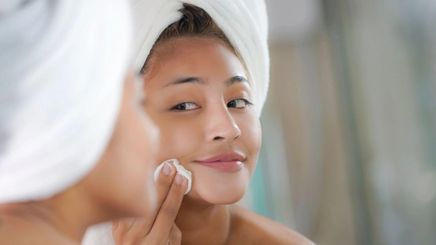
Much has been said about the importance of . It offers an array of benefits, from brightening to acne control. But when choosing an exfoliant that suits your skin type, things can get confusing really fast. Knowing the difference between AHA vs. BHA – the two most popular exfoliating agents in modern skincare – is crucial to getting it right.
If you love skin care, you have seen products with AHA and BHA labels. While these active ingredients look (and sound) similar, they target different skin concerns. One is better for , and one is better for . To help you find the perfect match, check out this comprehensive AHA vs. BHA breakdown.
What are AHAs?
The (AHA) family is found in certain foods, such as fermented milk, sugar cane, and fruits. They come in different molecular sizes – a.k.a penetration power. Smaller molecules can penetrate deeper into the skin, while larger molecules offer a more even exfoliation (and less irritation). The most popular AHA includes , lactic, citric, and malic acid. You can find them in varying formats, such as cleansers, toners, serums, and even body wash.
AHA benefits go beyond cleansing.
AHA is known for its brightening effects, but it can target other skin conditions. The water-soluble acid dissolves that accumulate on the top layer of the skin, improving texture and preventing that lead to acne. As it reaches the second layer of the skin (dermis), it breaks down old collagen fibers to make way for new ones.
In addition, and restore the . All these are beneficial if you’re dealing with uneven skin tone, melasma, , and fine lines.
Can you use AHA for your skin type?
Since AHA attracts moisture to the skin, it's a winner for dry skin. For beginners, it's better to start with lower-intensity formulas like lactic and malic acids. These have larger molecules, so they're less likely to cause irritation. Once your skin is used to AHAs, you can gradually increase the concentration or switch to something more potent, like glycolic acid.
AHA is also a suitable exfoliant for outdoorsy types because it can undo sun damage on the skin. However, using makes your skin extremely prone to sunburn, so be diligent with applying . The best way to prevent this side effect is by exfoliating your skin with AHA at night and washing your face in the morning.
What are BHAs?
Pimple-busting is the most popular beta-hydroxy acid (BHA). Between AHA vs. BHA, the latter has anti-inflammatory and antibacterial qualities that fight acne. It also helps boost the skin's resistance to UV damage. This versatile ingredient has many other advantages, and you can find it in many cosmetic products, from skincare to makeup.
BHAs have transformative benefits.
To differentiate AHA vs. BHA, the former is water-soluble, and the latter is oil-soluble. BHAs can bypass layers of oil inside pores, effectively unclogging them of , , and other debris. It also and prevents new buildup from forming.
Given their antibacterial nature, it's no wonder BHAs like salicylic acid are a popular choice for treating inflammatory acne. And since they have the same exfoliating power as AHAs, they also help improve the overall tone and texture of the skin.
Can you use BHA for your skin type?
BHAs are excellent exfoliants for oily and acne-prone skin. As with any active ingredient, slowly add BHA to your routine instead of immediately using the highest percentage in the market – these don’t always guarantee better results. Test it out on your skin and see how it reacts.
If your skin becomes red easily, consider using a product that combines BHA with other skin-calming ingredients. Try a gentle cleanser and exfoliant like Eskinol Pimple Relief Micellar Water with salicylic acid, cica, and . It removes makeup, soothes the skin, and fades pimple marks.
Frequently Asked Questions
Can I combine AHA and BHA?
It's not necessary to use both as they can be too much for the skin. However, some types of AHAs work better when paired with salicylic acid. For example, you can use a salicylic acid cleanser and a glycolic acid toner. It’s best to consult your dermatologist before layering them and don’t forget to do a !
Can I use AHA or BHA with niacinamide?
Definitely! In fact, they work better together. helps keep the skin moisturized after exfoliation and refines the appearance of pores. You can use POND'S Bright Miracle Ultimate Acne Control Facial Foam to get this benefit. Formulated with vitamin B3+ and the world's first Thymo-BHA, it treats acne from the root in only three days.
Can I use AHA or BHA with retinol?
While you can have exfoliants and in one skincare routine, using the two at the same time can lead to severe dryness. A workaround? . You can use either AHA or BHA today and do retinol the next day. Adding hydrating products with can also help keep your skin comfortable.
The AHA vs. BHA decision comes down to understanding your skin type and its specific needs. One acid is not better than the other – they simply deliver different benefits. If you’re dealing with rough texture and discoloration, AHAs are worth a shot. Meanwhile, if you need help refining your pores and eliminating acne, BHAs can be your champion.